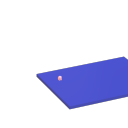Weird velocity behavior
Hello everyone!
I began using plugdata a couple days ago and I'm making a simple mono synth, I have already made basically everything except for a decent adsr and velocity implementation.
At first, I tried using the else/adsr for simplicity, but it caused me some problems (i.e the attack phase didn't enter the decay and sustain phase and for some reason, if I increased the attack time while the others were at 0 or 1 ms, the sound would not stop playing even after I released the key, until the attack time was over), so I tried making my own adsr envelope using a vline, I made some knobs for the adsr and packed them together so I could send the values to a message and use $ variables in the vline in order to program the ramp.
Everything works fine, until I added velocity sensitivity, I divided the velocity values from the notein -> mono object by 127, so I got a value between 0 and 1, and I packed it along with the adsr values, and sent all of them to the vline through a message.
The adsr works as intended, BUT the velocity isn't sent out from the pack unless I press at least TWO keys at the same time, if I play one single note, the adsr values are correctly sent to the vline, but the value that comes out of the pack for the velocity remains 0 until I play another note simultaneously.
I don't understand what's the issue here and I've been stuck on this specific problem for way too long, I hope you can help me understand what I'm doing wrong.
Automating vline~ envelope from a waveform (envelope as wavetable
Hi everyone,
I'm working on a system to automatically generate a vline~ message list starting from a custom envelope shape stored in an array, originally extracted from a .wav file.
I want to build a dynamic vline~ list like this: 0, 1 93.753, 1 0 187.506
But instead of typing values manually, I'd like to generate it automatically based on the shape of an envelope loaded from a waveform (array).
I already convert the array index to milliseconds using: [expr ($f1 / 44100) * 1000]
And I can manually draw or extract the envelope into an array — but I’m struggling to automate the construction of the vline~ list so it correctly represents:
- attacks
- holds
- releases
- plateaus (ecc)
at the moment i Load a .wav file containing an envelope shape, Store it into an array. Detect meaningful breakpoints (e.g. slope changes, thresholds) and Use those to automatically create a proper vline~ sequence.
here the patch and one env wav file
impose-envelope-wavetable-analog.pd
strike-1_6.wav
Is there a way to extract breakpoints or slope changes from an array to build a proper vline~ message?
Has anyone implemented something similar (using an envelope from a .wav as a wavetable)?
Would “wavetable envelope” be a good term for this? Is there a better one in Pd terminology?
Thanks in advance if anyone has ideas or guidance.
Even partial thoughts or pointers would help a lot!
I almost forgot: At the moment, I’m using GPT to convert the vline~ list into the format 0, 1 93.753, 1 0 187.506 (just an example), starting from a total duration in milliseconds — in this case, 2176 ms. This naturally results in very complex lists, like something along these lines:
0, 1 100, 0.6 400 100, 0.3 2000 500, 0.15 3000 2500, 0 10491 5500
I’d really like to find a way to resolve this and automate the process, but since I’m still a beginner, I wonder if I’m just making things unnecessarily complicated?
Emiliano
ELSE 1.0-0 RC13 with Live Electronics Tutorial Released
Ok, the cat is out of the bag --> https://github.com/porres/pd-else/releases/tag/1.0-rc13 I'm officialy announcing the update and uploaded binaries to deken for mac (intel/arm), Win and Linux. It all looks ok but tell me if you see something funny please. There's also a raspberry pi binary but not working 100%yet and we'll still look into that. Hopefully someone could help me/us with it. I might make another upload just for the pi later on if/when we figure it out. Find release notes and changelog below.
RELEASE NOTES:
Please support me on Patreon https://www.patreon.com/porres I'll now try to add special content for subscribers. You can follow me on instagram as well if you like... I'm always posting Pd development stuff over there https://www.instagram.com/alexandre.torres.porres/
It's been a little bit over 7 months since the last update and I almost broke the record for taking too long to release an update (which had happened in my previous update). So yeah, there's just too much to talk about! I guess the delays in releasing updates is because it's been a little tricky and hard to sync the release cycles of ELSE with PlugData, which includes ELSE in its download.
Plugdata 0.9.2 should come out soon with ELSE RC13 and it's supposedly the last update before 1.0.0, so I've heard. And the plans was to get to that still in 2025! This means ELSE could be at its last "Release Candidate" phase as I'm aiming to sync the final release with PlugData. Until then, I'll still make breaking changes and I can't wait until I can't do that anymore as I really feel bad. On the other hand, it's kind of inevitable when I'm always adding new stuff and redesigning and reconfiguring objects to include more functionalities. And I always got a lot of new stuff! So I'm thinking that I will eventually try some mechanism like Pd's compatibility flag or something. I'll try to come up with something like that in the next update.
This update has 22 new objects for a total of 573 and 26 new examples in my tutorial for a total of 554 examples. Let's dive into the highlights (see full changelog below after the release notes).
-
Multichannel Support: Last release had 92 MC aware objects, now it's 139! Over a 50% increase that include old and new objects (all the new ones have been coming with MC support). Virtually all oscillators and envelope generators now have MC support, plus some other random ones. Let me highlight the new [lace~]/[delace~] objects that are 'MC' tools that perform interleave/deinterleave in Multichannel connections. My bare minimum number of objects "to start with" would be at least a bit over half the number of signal objects. That was my target for 1.0! ELSE right now has 319 signal objects, so that'd be at least 160. I will definitely pass this milestone in the next update. I guess a good number of MC objects would be around 75% of the signal objects. I will aim for that as soon as I can. Some objects simply can't be MC at all, so 100% will never be the case, but maybe an ideal 90% eventually? We'll see... I am just proud and happy that ELSE is taking such a big jump on MC awareness in less than a couple years.
-
Envelope generators ([adsr~]/[asr~]/[envgen~]/[function~]) now have more curve options. For [adsr~]/[asr~] the default is now a new log curve that you can set the curve parameter (and was 'stolen' from SuperCollider). A new [smooth~] family of objects perform the same kind of curved smoothening for alternating inputs - [envgen~] and [function~] also have that but also '1-pole' filtering, 'sine' and 'hann' curves. You can now trigger [adsr~] and [asr~] with impulses.
-
The [play.file~] object now supports even more file formats besides MP3 and stuff. Hey, you can even stream the supported formats from weblinks! The [sfload] object (which loads files into arrays) also gained support for more formats and can download from weblinks as well! It also has a new threaded mode, so loading big files won't choke Pd. It now also outputs the file information, which is a way to tell you when loading finished in threaded mode. The [sample~], [player~], [gran.player~] and [pvoc.player~] objects are now also based on [sfload], so they support all these file formats!!! Now [sample~] and [tabplayer~] are integrated in a way that [tabplayer~] is always aware of the sample rate of the file loaded in [sample~] (so it reads in the "correct speed"). A new [sfinfo] object is able to extract looping regions and instrument metadata information from AIFF files (which is something I wanted for ages) - it should do more stuff in the future.
-
[knob] has become the ultimate featured bloated creep GUI I always feared and avoided. MAX is envy! but I'm happy with this structure and I want to replicate in other GUIs in the future (yeah, I got plans to offer alternatives to all iemguis). I wanna highlight a new 'param' symbol I added that allows you to remotely set a particular method in an object, so you don't to connect to a "method $1" message and you can even do this wirelessly with a send symbol. [knob] now also acts like a number box, where you can type in the value, which may also be displayed in different ways or the value can be sent elsewhere via another send symbol so you can temper with it using [makefilename] or [else/format]. I've been using this for the MERDA modules and it's really cool.
-
We finally have a [popmenu] GUI object! This was in my to do list forever and was crucial to improve the MERDA modules to set waveforms, instruments and whatnot.
-
Let's about MERDA, the "Modular Euroracks Dancing Along" subset of abstractions in ELSE. It was first released in the last update and it's been driving lots of the development in ELSE as you can see. I now added a MIDI Learn feature for all knobs that feels great and quite handy! There are many fixes and improvements in general and some new modules. I wanna highlight the new [sfont.m~] module, which loads "sound font" banks and you can just click on a [popmenu] to choose the instrument you want. The default bank has numerous (hundreds) options and also comes with PlugData. The sequencer module [seq8.m~] was rather worthless but it's now a whole new cool thingie. It allows you to set pitches with symbols and even has quarter tone resolution. I added a right outlet to send impulses to trigger envelopes and stuff (there's still more stuff of course, see full changelog below).
-
There are newly designed/renamed/recreated [resonbank~]/[resonbank2~] objects that are well suited for Modal Synthesis.
-
What actually drives my development is my Live Electronics tutorial, which got a fair upgrade with a new chapter on Modal Synthesis amongst other things, such as new subtractive synthesis examples and a revision of envelope generators with examples on AHDSR and DAHDSR - by the way, there are new gaterelease~/gatedelay~ objects for handling envelopes (and other processes).
-
I have to thank some people. Tim added 'zoom' to the [pic] object, as well as an image offset. Tim also implemented a new and better technique for bandlimited oscillators. Ben Wesh gave me a new [scope3d~] GUI object, pretty cool, that plots an oscilloscope in 3 dimensions, which is coded in LUA - and ELSE has been carrying a modified version of [pdlua] because it now depends on it for a couple of GUIs. Tim and Ben made many improvements to [pdlua] (as well as Albert Graef, of course).
-
For more new objects, let me also tell you about the simple and cool [float2imp~], that is based on [vline~] and can convert floats to impulses with sample accuracy (don't know why I didn't think of that earlier). A new [tanh~] object has Multichannel support. A bit earlier I made an update to Cyclone that actually "borrows" and includes this one from ELSE instead of its original one (which does not have Multichannel support). PlugData users will load the one from ELSE. This is another tiny step that sort of integrates ELSE and Cyclone, specially for PlugData users.
happy patching.
CHANGELOG:
LIBRARY:
Breaking changes:
- [adsr~]/[asr~]: now a gate off before reaching the sustain point does not start the release right away (this allows you to trigger it with impulses). There's a new mode just for immediate release. There's a new exponential setting for curve factors, the old 'log' mode is renamed to 'lag' as it's the same as used in the [lag~] object. For [adsr~], a bang now is not "retrigger", but an impulse at control rate, there's a new 'retrigger' message for control rate retriggering (and now it only retriggers if the gate is on). For [asr~] a bang now also works like an impulse.
- [sample~]: no more 'load' message, args to 'open' message changed, size is now only in 'ms'.
- [format]: outputs are now always symbols, before you could get float outputs. Also, we just have a simplified symbol output, no more lists or anythings. Hopefully I'll be able to get the 'list' output back, but it involved some bugs that I couldn't fix so I just removed it. You cannot use bangs and lists in secondary inlets no more (this is cylone/max crappy paradigm we don't want here). Bang method was actually removed as well.
- [pack2]: no more support for anythings, also no more support for lists in secondary inlets and output has a list selector (I wanna make this more Pd like and not a silly clone from MAX's [pak], cause fuck MAX).
- [merge]/[unmerge]/[group]: no more '-trim' flag (again, respecting pd's usual list paradigm), in [merge] now there's no more 'hot' argument and a bang now represents an empty list and inlets initialized with empty lists
- [mono]: 1st argument is now 'glide' in ms.
- [sfont~] now uses 'mma' for bank selection (this alters how CC messages set the bank number).
- [player~]/[play.file~]: 'open' message does not play files right away anymore.
- [tabplayer~]/[player~]: play message without args now play at the default settings (whole file at regular speed).
- [envgen~]: removed the 'maxsustain' parameter, use the new [gaterelease~] or [gaterelease] objects instead. Removed the rightmost inlet just to set envelopes, now a list input only sets the envelope and doesn't trigger it. The 'set' message is then removed.
- [envgen~]/[function~]: simplified and got rid of '-exp' flag and message, also deleted 'expl' and 'expi' messages. A new 'curve' and cimpler message sets exponential factors for all or individual segments, and includes more curve formats.
- [knob]: 'esc' key now deactivates the object. The 'ticks' message is renamed to 'steps' and there is a new 'ticks' message that toggles showing ticks on and off. The 'start' message has been renamed to 'arcstart'. The 'outline' message has been renamed to 'square' for better clarity. Design changed a bit to make it like it is in PlugData (they won), so we now fill the whole background color when in 'square mode' and the knob circle has an 85% proportion in this case inside the full 100% square size (so it grows bigger when not in 'square' mode). Now, by default, the GUI is in a new 'loadbang' mode (I don't think this will influence old patches). I'm afraid some old patches might behave really weird since I added a lot of new stuff. I changed the 'load' message behaviour to not update the object (this can arguably be considered a bug fix).
- [wavetable~], [bl.wavetable~] and [wt2d~]: 'set' message now sets frequencies because of the MC support in [wt~] and [wt2d~], while there's a new 'table' method to set the table name.
- [gbman~]/[cusp~] list method is now for MC, old list method is now renamed back to an old 'coeffs' method.
- [f2s~]/[float2sig~] default value is now 10 ms.
- [op] now behaves like [*~] where the smaller list wraps til reaching the size of the longer one.
- [list.seq] does not loop anymore by default.
- [impseq~] list input removed, use the new [float2imp~] object to convert floats to impulses.
- [resonant~] now has 'q' as the default.
- [resonant2~] has been removed.
- [decay2~] has also been removed ([asr~] much better).
- [vcf2~] has been renamed to [resonator2~].
- [resonbank~]/[resonbank2~] have basically been deleted and replaced by new objects with the same name... [resonator~] is based on a new [resonator~] object which is similar to [resonant~] and [resonbank2~] is now based on [resonator2~] (old [vcf2~] instead of [resonant2~] that got deleted). These are well suited objects for Modal Synthesis.
- [oscbank~] now uses a 'partial' list and not a frequency list. The freq input now defaults to '1' and this makes [oscbank2~] completely obsolete.
- [oscbank2~] has been deleted since it became completely obsolete.
- [sfload] load message changed the behaviour a bit.
Enhancements/fixes/other changes:
- [adsr~]: We have now a new mode for immediate release (see breaking changes above, I'm not repeating it). Fixed ADSR signal inputs (it was simply not really working, specially for linear). Fixed status output for MC signals. There's a new curve parameter that allows you to set the curvature.
- [asr~] I actually just made the new [adsr~] code into a new [asr~] code as a simplified version (as it was before)... so it's got the same impromevents/fixes.
- [play.file~]: added support for more file formats and even weblinks for online streaming!
- [sfload]: added an outlet to output information, added threaded mode, added support for more file formats and even weblinks for downloading.
- [sample~], [player~], [gran.player~] and [pvoc.player~] are now also based on [sfload], so they support more file formats!
- [sample~]: improved extension management with [file splitext].
- [sample~] and [tabplayer~] now are automatically integrated in a way that [tabplayer~] is always aware of the sample rate of the file loaded in [sample~], so it automatically adjusts the reading speed if it is different than the one Pd is running with.
- [numbox~]'s number display is not preceded by "~" anymore (that was just kinda stupid to have).
- [format]: fixed issues where empty symbols and symbols with escaped spaces didn't work. Added support '%a' and '%A' type. Added support for an escaped 'space' flag. Improved and added support for length modifiers. Improved syntax check which prevents a crash. Improved documentation.
- [knob]: added new 'param', 'var', 'savestate', 'read only', 'loadbang', "active", "reset" and 'ticks' methods. Added the possibility to type in number values and also modes on how to display these number values, plus new send symbols for 'activity', 'typing', 'tab' and 'enter'. New design more like plugdata. Changed some shortcuts to make it simpler. If you have the yet unreleased Pd 0.56-0 you can also use 'double clicking' in the same way that works in PlugData. Properties were also significantly improved (I'm finally starting to learn how to deal with this tcl/tk thingie). Yup, a lot of shit here...
- [autofade2~]/[autofade2.mc~]: fixed immediate jump up for 0 ramp up.
- [synth~]: fixed polyphony bug.
- [metronome~]: fixed bug with 'set' message.
- [midi2note]: fixed range (octaves 0-8).
- [pulsecount~]: fixed reset count to not output immediately, added bang to reset counter at control rate
- [click]: fixed regression bug where it stopped working.
- [else]: new 'dir' method to output ELSE's binary directory in a new rightmost outlet. The print information also includes the directory.
- [pic]: added zoom capability finally (thanks to tim schoen) and added offset message (also thanks to tim).
- [store]: added 'sort' functionality.
- [scales]: fixed octave number argument. Added functionality to allow octave number as part of the note symbol.
- [mono]: added 'glide' parameter, as in [mono~].
- [pluck~]: fixed list input.
- [rescale]/[rescale~]: added a "reverse log" mode.
- [limit]: added a new second ignore mode.
- [graph~]: added an external source input for plotting the graph and a 'clear' message.
- [canvas.setname]: added a new argument for "abstraction mode" and methods to set name, depth (and mode).
- [midi.learn]: added a new argument for "abstraction mode", fixed 'dirty' message sent to parent.
- [brickwall~]: fixed initialization.
- [list.seq]: added a loop mode and a 2nd outlet to send a bang when the sequence is done.
- [delete]: fixed index for positive numbers.
- [dust~]: added 'list', 'set' and '-mc' flag for managing the already existing Multichannel capabilities.
- Thanks to Tim we have many fixes and a whole new technique for band limited oscillators. Now [bl.saw~], [bl.saw2~], [bl.vsaw~], [bl.square~], [bl.tri~], [bl.imp~] and [bl.imp2~] have been redesigned to implement elliptic blep, which should provide better anti-aliasing.
- [parabolic~] now uses and internal wavetable for more efficiency.
- [resonant~]: added 'bw' resonance mode.
- [lowpass~]/[highpass~]: added 't60' resonance mode.
- [quantizer~]/[quantizer]: added a new mode, which combines floor (for negative) and ceil (for positive) values.
- [crusher~]: now uses the new [quantizer~] mode from above (arguably a breaking change).
- [envgen~]: fixed a bug (actually a misconception) where ramps started one sample earlier. Fixed 0-length lines. Added a possibility to set time in samples instead of ms. Maximum number of lines is now 1024. Added loop mode. Added many curve options (sin/hann/log curve/lag).
- [function~]: Added many curve options (sin/hann/log curve/lag).
- [The out~] family of abstractions now use [bitnormal~] so you won't blow your speakers beyond repair in edge cases.
- [trig.delay~]/[trig.delay2~]: fixed bug where impulse values different than '1' didn't work.
- Added MC support to: [trig.delay~], [trig.delay2~], [gatehold~], [vca.m~], [gain2~], [decay~], [asr~], [envgen~], [function~], [bl.osc~], [bl.saw~], [bl.saw2~], [bl.vsaw~], [bl.square~], [bl.tri~], [bl.imp~], [bl.imp2~], [imp2~], [tri~], [saw~], [saw2~], [vsaw~], [square~], [pulse~], [parabolic~], [gaussian~], [wavetable~], [wt2d~], [randpulse~], [randpulse2~], [stepnoise~], [rampnoise~] [pink~], [gbamn~], [cusp~], [gray~] and [white~].
- Also added MIDI input and soft sync to [imp2~], [tri~], [saw~], [saw2~], [vsaw~], [square~], [pulse~], [gaussian~] and [parabolic~].
- [wavetable~] and [wt2d~] gained args to set xfading.
- Updated pdlua to 0.12.23.
- M.E.R.D.A: Added MIDI-LEARN for all modules (this is only for the knobs). Replaced some number boxes that were attached to knobs by an internal number display mechanism (new feature from knob). Improved interface of [gendyn.m~]. Preset/symbol name fixes to [flanger.m~]. Now we have automatic MIDI mode detection for [plaits.m~] and [pluck.m~] when no signals are connected (still trying to get plaits right, huh? Yup! And bow MIDI input with monophony and trigger mode has been fixed in [plaits.m~]). Added MC support to [vca.m~]. Increased range of [drive.m~] down to 0.1. Changed some objects to include the new [popmenu] GUI. [vco.m~] now uses the new MC functionalities of oscillators and doesn't need to load abstractions into [clone], I hope it makes this more efficient and clean. The [seq8.m~] module was worthless and got a decent upgrade, it's practically a new module. Added new modules (see below). Note that MERDA is still at alpha development phase, much experimental. Expect changes as it evolves.
- 22 new objects: [float2imp~], [lace], [delace], [lace~], [delace~], [gatehold], [gatedelay],[gatedelay~], [gaterelease~], [gaterelease], [popmenu], [scope3d~], [tanh~], [resonator~], [sfinfo], [smooth], [smooth2], [smooth~], [smooth2~], [dbgain~], [level~] plus [crusher.m~], [sfont.m~] and [level.m~] MERDA Modules.
Objects count: total of 573 (319 signal objects [139 of which are MC aware] and 254 control objects)!
- 323 coded objects (210 signal objects / 113 control objects)
- 227 abstractions objects (87 signal objects / 140 control objects)
- 23 MERDA modular abstractions (22 audio / 1 control)
TUTORIAL:
- New examples and revisions to add the new objects, features and breaking changes in ELSE.
- Added the MERDA modules into the examples for reference.
- Revised section on envelopes.
- New subtractive synthesis examples.
- New chapter on Modal Synthesis.
- Total number of examples is now 554! (26 new ones)
[vline~] may not start at block boundaries
@porres Thanks for your interest! This is an envelope generator that is trying to copy and improve on an effect I used in a piece way back in the '90s. It was originally done with a Valley People Gatex, which I'm about to give away to the friend who turned me on to them. Anyway, if I set the Gatex to 0.2s release time, a 60dB range, and then ride the threshold to constantly trigger on an external key (for which I usually used speech so it would be fast and unpredictable), I'd get a pleasing chattering sound with a consistent soft click on the attack. Even though the release is so short, the triggers are coming awfully fast so the gate is retriggering before it has had a chance to fully close.
I made some recordings of the Gatex and tried to measure what it was doing, but as these things often go, I found that the Pd simulation sounded more true to the original with parameters that didn't quite match what I had measured. The release curve I'm using is much steeper at the beginning, release time much longer, and the attack curve is longer and logarithmic. I kept the 20ms sustain time as is. I found that if I retriggered the same [vline~] before it had had a chance to fully release, it would either pop too much (if I made it jump to 0 first), or had inconsistent attacks (if the new attack didn't start from 0), so that's why there's two of them computing the ramps and hold. I'm outputting whichever one is higher at any given moment. When a new trigger comes in, I look to see which EG is lower (and thus not seen on the output) and route the new trigger to it. It first jumps to 0, but you don't hear it click because I'm outputting the other one at that instant.
To control the curvature of the attack and release, I use [vline~] again to synchronize the values used to shape the attack and release via [pow~]. Finally, I noticed that the Gatex had a unpredictable amplitude variation, probably based on the key signal at the moment the trigger was detected. That's what the randomized volume stuff is for, although the Gatex's actual variation is only 3 dB, if that. I'm not trying to copy their detection algorithm because for my music there's usually been no correlation between the main channel and the side chain, so I just use randomized [delay]s to trigger it, which is how my troubles began. Without the intervening [vline~], the unsynchronized random volume part added unpredictable discontinuities, especially when the trigger density was high.
Here's some sound: jittery gate demo.mp3
[vline~] may not start at block boundaries
@lacuna said:
click bang [o] (GUI always on block-boundary) > [spigot] opens > [bang~] bangs > [spigot] closes > [vline~] starts (still on same block-boundary).
Yes, this is how I was hoping it would work, but it's not always the case that [bang~] bangs after the spigot is open within the same control block. It appears to bang afterward if there is a direct bang from a GUI element, but bangs before if the bang came from a delay. (Edit: I'm going to start a new topic on this, I don't see why this should be true)
bang~ runs last.pd
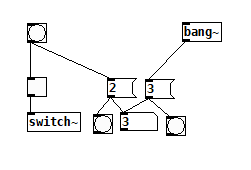 bang~ runs first.pd
bang~ runs first.pd
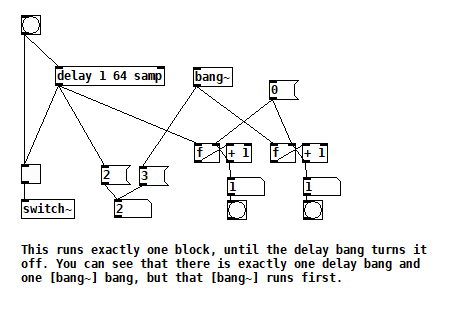 If it runs before, then we are really waiting until it bangs at the end of the next audio block. (BTW, you can modify the number of blocks of delay and see the numbers change as you'd expect)
If it runs before, then we are really waiting until it bangs at the end of the next audio block. (BTW, you can modify the number of blocks of delay and see the numbers change as you'd expect)
You use [rpole~ 1] as sample-counter, right? But [snapshot~] only snapshots on block-boundaries.
Yes, but all I'm concluding from that is that the message is available in the control block before the audio block that contains its actual time. The fact that so many Pd objects ignore the fractional block of time remaining suggests to me that it could be possible to truncate that fractional block of time in the message in order to make objects like vline~ start at the beginning of the audio block, like sig~.
So is it correct that you want to move the start of vline~ 'backward' ? To the start of the block?
Your diagram annotation is correct, but "want" is a strong word  . Let's just say I'm curious if it's possible. Right now, I'm delaying things like [sig~] to match [vline~] by inserting [vline~] just before them. I could have used any of our 3 quantizers to align the first [vline~] ramp with the block following the block that contains the fractional block timed message, but then I would have had to also delay my [sig~] processing a block as @seb-harmonik-ar confirmed.
. Let's just say I'm curious if it's possible. Right now, I'm delaying things like [sig~] to match [vline~] by inserting [vline~] just before them. I could have used any of our 3 quantizers to align the first [vline~] ramp with the block following the block that contains the fractional block timed message, but then I would have had to also delay my [sig~] processing a block as @seb-harmonik-ar confirmed.
The last two slides in that PP deck you linked to shows what I mean. Objects like [vline~] implement the ideal, but I'm wondering how to make it behave more like the last slide. See how the message's timing is labeled "t0+16"? Wouldn't it be possible just to zero out the "16" part?
[vline~] may not start at block boundaries
@jameslo Busy elsewhere, but still thinking about this of course.
vline~blockquantiser...
Interesting that [print~] prints identical blocks for both bangs (actually not very interesting).
[tabwrite~] starts writing the array from the beginning of the previous block when it gets its bang from [del 1] at the end of that block (as I mentioned above) and then writes 192 points...... but the spigot then only lets through the next bang to [vline~] 64 samples later ... ([bang~] every block.... Godot).....
I.e the two [print~]'s are simply one block apart as displayed in the array.
But I admit to also having lost track of the actual problem.
Do you want to trigger [vline~] between blocks?
If so you should bang the message to [vline~] from [del 1] instead of your sub-patch inlet and then [vline~] will be scheduled to start within the block (at 1 millisecond in).
But if you wanted it to be triggered at the next boundary vline~blockquantiser does exactly that...!.
hmm.pd
David.
[vline~] may not start at block boundaries
@jameslo For me it is difficult to understand. Maybe I am missing the whole point and all I say is off topic.
First of all, I honestly don't understand why your left bang works
click bang [o] (GUI always on block-boundary) > [spigot] opens > [bang~] bangs > [spigot] closes > [vline~] starts (still on same block-boundary).
Similarly, in my first response to you, you can see in the snapshots that the bang from [delay 1.5 64 samp] is being processed during Ctrl 1, 32 samples before its real timing.
This I don't understand.
You use [rpole~ 1] as sample-counter, right? But [snapshot~] only snapshots on block-boundaries. (That's why there is [vsnapshot~], but that was buggy, when I last tried it.) [snapshot~] shows 64 samples, one whole block.
If you snapshot later, you see [del 1.5 64] outputs bang after 96 samples:
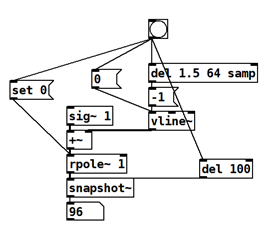
([sig~] also updates its output only on block-boundaries, not within the block.)
@seb-harmonik-ar s [pip~] could be done with [bang~] and [timer], to measure the time that has passed into the block.
Or for signalrate~ output~ with [rpole~ 1], to measure the samples past into the block.
you don't need to predict the future to make it one block earlier
So is it correct that you want to move the start of vline~ 'backward' ? To the start of the block? To the start of that block where [del] outputs later on a message to [vline~]?
Clicking [o] bang at ctrl 0 > [del 1] outputs after 1 ms, where audio 0 is happening > [vline~] should have started before, at the beginning of audio 0 ?
Is this what you want?
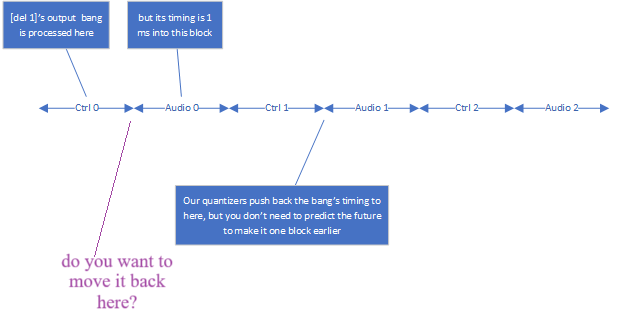
Here is a paper where message- vs signal-domain and scheduleing are graphed. It is in German, maybe you can use a translator and the time-graphs on the last pages are english / self-explanatory. And you problably already know all of this.
https://iaem.at/kurse/ss19/iaa/pdscheduler.pdf/view
[vline~] may not start at block boundaries
@jameslo said:


In the middle of a message cascade you may schedule another one at a delay of zero. This delayed cascade happens after the present cascade has finished, but at the same logical time".
Man, this got me excited because the only reason my bang quantizer outputs where it does and not one block earlier is because [bang~] for the end of the first block has already executed by the time my spigot opens and so we have to wait for the next audio block to complete. I was hoping [delay 0] would cause the bang from [bang~] to be rescheduled after my spigot opens, but it doesn't appear to.
That works, screenshot when left bang is clicked:
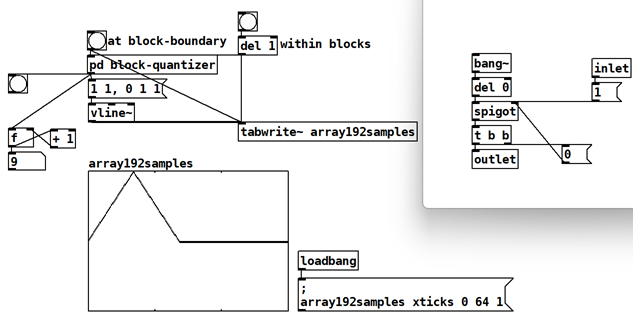
vline~blockquantizer.pd
(thought [bang~] would be expensive, that's why I [switch~]ed it in the other patch.)
[vline~] may not start at block boundaries
@jameslo said:
Is there a way to zero out that bang timing attribute, so that the bangs are quantized to block boundaries? Or some other way to force [vline~] to start at the beginning of the next audio block?
Like this?
vline~onnextblockboundary.pd
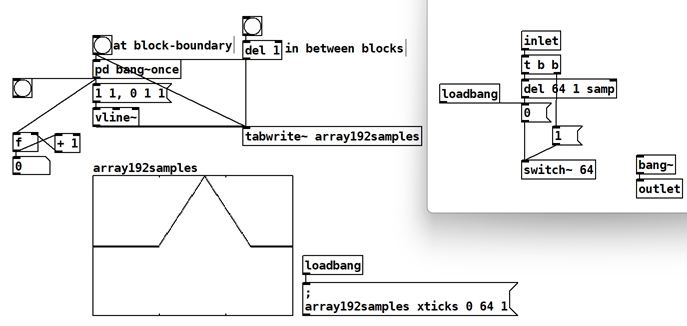
Edit: it's not just bangs that have that intra-block timing attribute--you can see in my example that it's preserved through the message that's sent to [vline~]
As far as I understand it now, some objects
([metro] [del] [pipe] [vline~] maybe[vsnapshot~])
do intra-block-messaging/banging and some won't (like [tabwrite~] in my patch).
The scheduler processes GUI and Midi i/o at block-boundaries.
I am highly interested in how to sync or interface Reaper or other DAW with PD control rate sample-accurately intra-blocks.
[vline~] may not start at block boundaries
This sentence in timer-help helped me find a bug in one of my envelope generators made with [vline~]:

I was wondering why [timer] sometimes returned fractions when set to [tempo 64 samp(--now I know. But hold on--bangs are only processed between audio blocks, so that implies that the bang must carry with it some attribute that indicates its actual timing, one which might be within the next audio block.
Awright, then maybe [vline~], being all sophisticated and stuff, takes a peak at that attribute? Holy smokes, yes it does:
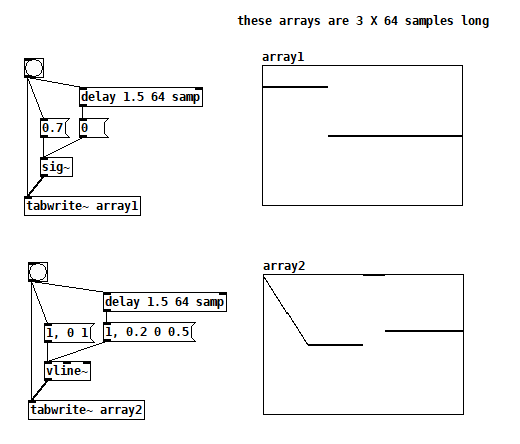
So my mistake was assuming that [vline~] always started at block boundaries, and that made it misaligned with other audio processing that was initiated at block boundaries. How have folks dealt with this? I suppose I could look for a way to use [vline~] to potentially delay the other audio processing. Is there a way to zero out that bang timing attribute, so that the bangs are quantized to block boundaries? Or some other way to force [vline~] to start at the beginning of the next audio block?
Edit: it's not just bangs that have that intra-block timing attribute--you can see in my example that it's preserved through the message that's sent to [vline~]


